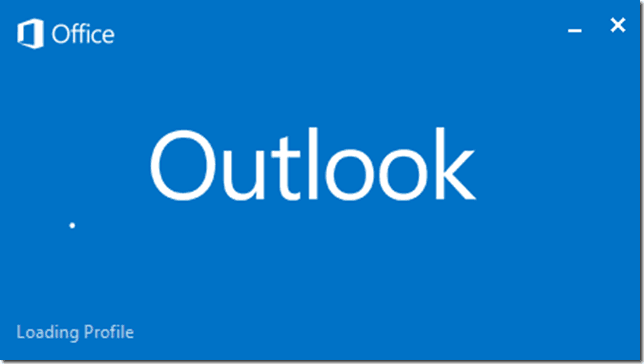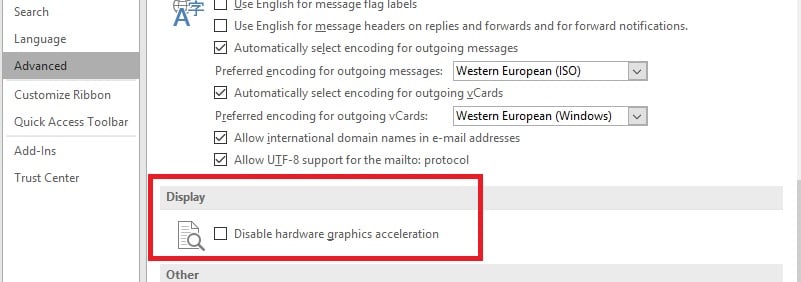All of a sudden, someday, Outlook 2013 stuck at start and goes into a loop of “Loading Profile” screen and won’t go ahead even after waiting for hours. This issue was pervasive in Windows 8, and now it’s been observed on Windows 10 too. And if you think that your .pst file has gone bad or got corrupted, and you try to rename it or move it, Outlook won’t let that happen when you may have killed the Outlook entirely from task manager. So, let’s fix these issues:
[Fix] Outlook 2013 is Stuck at “Loading Profile” Screen
Solution 1
If Outlook is not allowing you to rename your .pst file, that means either Outlook is still using it or if you have any indexing application installed in your computer like Copernic, then more chances are that Copernic is indexing it. So, with outlook, you need to kill your indexing software too. Upon doing so, try renaming the .pst file and check if Outlook opens. If it does, that means your Outlook Personal folder file (.pst) got corrupted. So, you need to repair that, follow below-given steps:
How to Repair a .pst file
- Exit Outlook, and browse to <drive>:\Program Files — or, if you see a Program Files (x86) folder on the same drive, browse to that instead. For example, C:\Program Files or C:\Program Files (x86).
- In the Search box, type Scanpst.exe.
If the search doesn’t find Scanpst.exe, try searching in the alternative folder mentioned in step 2, above — Program Files or Program Files (x86).
- Double-click Scanpst.exe.
- In the Enter the name of the file you want to scan box, enter the name of the .pst file you want the tool to check, or click Browse to select the file.
- By default, a new log file is created during the scan. Or, you can click Options and choose not to have a log created, or to have the results appended to an existing log file.
- Click Start.
If the scan finds errors, you’re prompted to start the repair process to fix them.
The scan creates a backup file during the repair process. To change the default name or location of this backup file, in the Enter name of the backup file box, enter a new name, or click Browse to select the file you want to use.
- Click Repair. A copy of the log file is saved to the same folder as the .pst file.
- Start Outlook with the profile that contains the Outlook Data File that you repaired.
- Switch to the Folder List view in the Folder Pane by pressing Ctrl+6.
In the Folder Pane, you might see a folder named Recovered Personal Folders that contains your default Outlook folders or a Lost and Found folder. Although the repair process might recreate some of the folders, they may be empty. The Lost and Found folder contain any folders and items recovered by the repair tool that Outlook can’t place in their original structure.
You can create an Outlook Data File, and drag the items in the Lost and Found folder into the new data file. After you’ve moved all the items, you can remove the Recovered Personal Folders (.pst) file. This includes the Lost and Found folder.
If you can open the original Outlook Data File, you may be able to recover additional items. The Inbox Repair tool creates a backup file with the same name as the original, but with a .bak extension, and saves it in the same folder. You may be able to recover items from the backup file that the Inbox Repair tool couldn’t recover.
To recover items from the backup (.bak) file, make a copy of it and give the copy a new name with a .pst extension, such as bak.pst. Import the bak.pst file into Outlook, and then use the Import and Export Wizard to import any additional recovered items into the newly created .pst file.
Solution 2
Press Windows Key + X > Select Command Prompt (Admin)
Type in following command and press enter:
chkdsk c: /f
Restart your computer. Now Outlook 2013 should open without any issue.
Solution 3
Sometimes “Loading Profile” issue also occurs because of conflict with any add-ons or profile corruption. To fix these issues, follow below-given steps:
- You need to open Outlook in Safe mode. For doing so:
- Press Windows key + R. When Run command box opens:
- Type –
Outlook /safeand press Enter. - Now, if your Outlook 2013 opens, disable the faulty add-ons:
- Go to Outlook 2013 > File > Options.
- Click on Add-ons > Select COM Add-ins under Manage > Go
- Disable all add-ins or the ones you think could be faulty.
- Click OK.
- Close the Outlook 2013 and re-open normally using the icon on the desktop or from the Start menu.
Or even your Outlook 2013 doesn’t open in Safe mode; you need to create a new profile. To create a new profile in Outlook 2013, check the steps given at this link.
Solution 4
If you have SonicWall VPN or any other VPN software installed, either uninstall them or remove the application from the startup of windows and then restart your computer. If VPN software is the culprit, disabling their automatic startup or uninstalling them should resolve the issue.
Solution 5
If you work in a corporate where uninstalling a VPN service is not allowed and opening the Outlook 2013 in safe mode works fine for you, that means add-ins from VPN software are creating the trouble for you. So, try to run either of the following commands in Run command box:
outlook.exe /resetnavpane or outlook.exe /resetfolders
If Outlook works fine after running the first command, let it be or try 2nd command. Any of the ones should work for you. But upon running 2nd command, it would take a while before Outlook may open successfully.
Solution 6 (For Windows 7 and 8 users)
Open Run command box by pressing Windows key + R.
Type in services.msc and Enter.
Locate “Desktop Window Manager Session Manager” and double click it.
Change Startup type: from Automatic to Disabled.
Restart your computer. Now Outlook 2013 should Open fine.
Solution 7
If you use Lync, close it.
Open Task Manager, find Lync application in the Processes tab.
Right-click on it and select End Task.
Now Outlook 2013 should open fine.
Solution 8
Kill “Desktop Windows Manager” (in Windows 10) in Task Manager.
For Windows 7 and 8 users, Solution 6 is applicable to you.
Now Open Outlook 2013 and Verify.
Solution 9
If out Outlook is stuck or crashed while you were trying to set up an email account, that means you have a corrupted file. So, you’ll need to remove the profiles of Outlook from the registry. Follow the given steps:
Open Registry Editor by typing regedit in Run command box and Enter.
Navigate to the following path in Registry Editor:
HKEY_CURRENT_USER\Software\Microsoft\Office\15.0\Outlook\Profiles\<Your Profile>
Delete every profile or the profile for which Outlook is giving you trouble.
Also, delete those profiles from the following path:
C:\Users\<Your User>\AppData\Local\Microsoft\Outlook
Now open Outlook 2013 and reconfigure your Email-accounts.
Solution 10
Sometimes Hardware Acceleration, too, can cause the issue. Open Outlook in Safe mode, as mentioned in Solution 3 and go to:
File > Options > Advanced
Scroll down to Display and Tick Check on “Disable Hardware Graphics Acceleration“.
Close Outlook 2013 and Restart your Computer.




You are awesome, thank you so much!
Outlook 2016 hangs on loading profile for over 2 minutes.
NON-WORKING SOLUTIONS:
———————-
1. Creating a new Outlook profile.
2. Quick repair.
3. Full repair (gave me an error and used Microsoft’s tool to remove all office projects and re-installed everything.)
4. Deleted the Outlook folder (including all OST files) and let things get re-created.
5. Disable hardware acceleration.
6. Started outlook.exe /safe which opens fast.
7. Disabled all COM add-ins.
8. Disk Cleanup
9. All windows/office updates completed.
10. Disabled IPv6.
11. Ran the SARA (Support and Recovery Assistance) troubleshooting
12. Tried the “Run this program in compatibility mode for” on the shortcut.
WORKING SOLUTION:
———————-
Disable the following network adapters:
Microsoft Loopback Adapter
Npcap Loopback Adapter
After this, outlook would open within 5 seconds and not hang on loading profile anymore. I also you recommend to just disable any network adapter you’re not using.
OTHER THROUGHTS
—————
Why does Outlook search other network adapters?
Thanks a lot for the extended solution. It shall help a lot of people in future.
Solution 3 fixed my problem. Thank you very much!